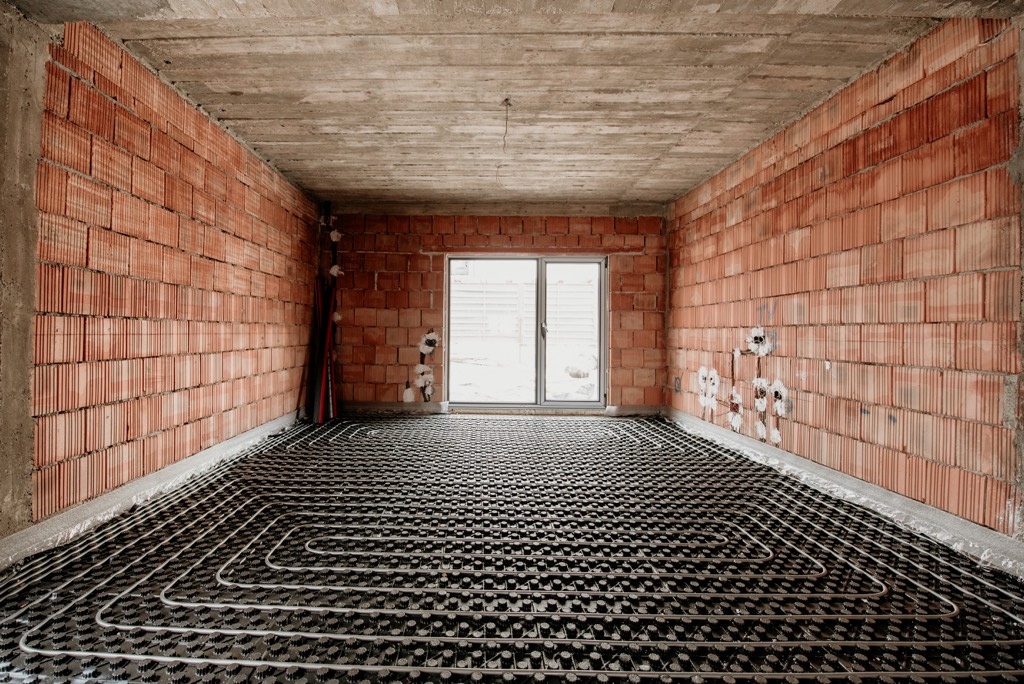Introduction to underfloor heating
Underfloor heating works the same way as a radiator. But instead of radiating heat from a metal panel attached to the wall, heat is radiated from the floor in your house.
There are two main types of underfloor heating systems: electric and water-based. Electric systems use heating mats or cables installed under the floor, while water-based systems use pipes that circulate hot water beneath the floor.
Water based systems were traditionally powered by a gas boiler. However, any source can heat the liquid inside. This is the type of underfloor heating that works with air source heat pumps and the type that we’ll focus on in this article. As a side note, electric underfloor heating is very costly to run and not suitable for householders looking to save money on their energy bills.
Wet underfloor heating systems break down further into two categories – buried and surface mounted.
Buried underfloor heating
With buried underfloor heating you lay the pipes beneath the floor itself. Normally the pipes are laid on top of the floor insulation using pipe stables to fix them. A screed is then poured into the pipe cavity to provide a smooth finish ready for the final floor layer. When the heating is switched on, hot water in the pipes heats up the whole screed layer ensuring the slow transfer of heat
Laying buried underfloor heating is a messy business. It means a good deal of disruption to your home as well as laying down a whole new wet floor. You’ll also need to allow the screed to dry for several weeks after the installers have finished before you can put on the final floor layer. For this reason it’s normally best suited to full scale renovation projects or if you are having a new extension installed.
Surface mounted underfloor heating
If you are not doing any major renovation work to your house, then you might not be too keen to rip up the floor. In this case you could opt for surface mounted underfloor heating. These systems consist of insulated panels with thin pipes side and you can lay them on top of the existing floor structure. The good news with these systems is that they only add about 1.5cm to the floor height. The bad news is that you may need to adjust things like skirtings and architraves to make them fit.
Heat pumps and underfloor heating
One of the great things about water based underfloor heating is that it radiates heat over a very large area. Because of this, it can work with a lower water temperature than normal radiators. This makes them ideal for air source heat pumps, which generally heat water to a lower temperature than gas boilers.
How much does underfloor heating cost to install?

As with all building costs, it’s a bit of a how long is a piece of string question. Realistically however you could end up paying anything from £120 per square meter for a clean new build installation to £200 per square meter for a renovation. Obviously the bigger the job, the less it will cost per square meter as economies of scale kick in.
How much does underfloor heating cost to run?
Here is where you’ll really notice the savings. Even with a conventional gas boiler, underfloor heating can be up to 25% more efficient than radiators. When paired with an air source heat pump however, you could be looking at a whopping 40% energy efficiency savings. That’s why underfloor heating goes so beautifully with heat pumps.
Because a buried underfloor heating system is set in a screed, it will generally be less responsive than a radiator. This means that it will take longer to heat up, but will retain heat for a much longer period. The reaction time will depend on the type and thickness of the screed used. Many people find it’s more efficient to run their underfloor heating constantly, but just have it turn down during the night.
What kind of floor can I put on top?
The short answer is most floors. Although carpet can be laid over underfloor heating, it isn’t always the most efficient. Tiles are normally a good choice as is natural stone. Engineered wood can also work well. Your installer will be able to advise you on this.
Are there any alternatives to underfloor heating if I want a heat pump?
This all depends on the existing energy efficiency of your house. Typically for a house currently running on a traditional gas boiler, some kind of upgrade to the radiation surface area will be necessary. The main alternative to installing underfloor heating is to upgrade the radiators. We cover this in more detail in our guide to radiators and heat pumps.
Depending on the age and construction of your house, you may also need to upgrade your insulation and windows.
The pros and cons of underfloor heating and heat pumps
TLDR? We’ve put together this simple table of pros and cons to figure out whether underfloor heating is right for you.
| Pros | Cons |
| Works beautifully with heat pumps | More expensive to install than radiators |
| Provides a constant temperature in the room | Can be very disruptive to install |
| Saves radiator floor space | Will limit floor selection (although not to a huge extent |
| Much cheaper to run (when combined with a heat pump) than gas and radiators |

